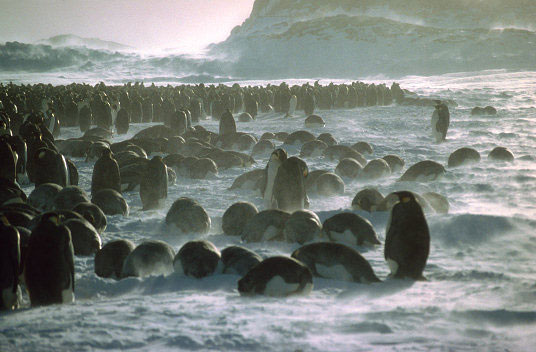Model of a crowd of penguins gathered to share the warmth
The new model discovered how penguins share fair warmth with each other.
Penguins face the harsh cold and icy winds of Antarctica that often huddle together into large groups to be warmer during the storms.
Mathematicians at the University of California, Merced (UC Merced) have created a model of penguins gathering, arguing that each penguin joins a gathering group only to minimize the heat loss of it's him. Surprisingly, this model shows that behavioral results such as 'self-centered' result in a carefree sharing of warmth.
The results are published online in PLoS ONE, researchers will discuss their findings at the annual meeting of the Division of Fluid Dynamics (DFD), of the Association. American Physical Society (APS), held on October 18-20 in San Diego, California.

Penguins are not a typical research topic by Francois Blanchette, an applied mathematician at UC Merced. This mathematician mainly focused on fluid dynamics. However, after seeing the penguins gather in the movie "March of the Penguins". Blanchette realized that important elements shaped the penguins, including wind and heat flow, these factors are in his area of expertise.
Blanchette and his colleagues, Arnold Kim and Aaron Waters, modeled the crowds of penguins, only outside penguins could move. Each penguin in the crowd emits heat that is blown away by the wind. By considering factors such as the number of penguins in the group and the power and turbulence of the wind, the model calculates which penguin in the outside is coldest. The coldest penguin moves to the best shielded area available, often moving from the top of the wind toward the end of the wind direction, and then distributing heat around the stacked penguins. . Repetition shows that the penguin swarms slowly and slowly toward the windward direction over time.
At first the model had constant wind and homogeneous birds, but the results showed that the penguins had a longer and slimmer shape than what was observed in nature. When the researchers added unstable factors such as abnormal whirlwinds and natural differences in the size and cold tolerance of each penguin, the penguin pattern was closer to the same. reality.

The researchers were surprised because the model showed that the penguins shared warmth almost equally."Even if the penguins are just selfish, just trying to find the best position for themselves and not thinking about their community, there is still equality in the amount of time each penguin continues to take. contact with the wind, " Blanchette said. 'Not all isolated cases of selfish behavior result in such fair results,' he notes. "The crowd of penguins is a self-sufficient system in which these birds rely on others for protection, and I think that's what makes it fair. If you have some the kind of obstacle, like a wall, then I thought it would be no more fair, ' Blanchette said.
Now researchers want to receive feedback from biologists before they continue to refine the models. However, collecting experimental data is difficult, Blanchette said. Mathematicians hope their work can serve as a guide for scientists in this area, helping them know what observations to make to test the model.
Blanchette said his team could also study how this model adapted to describe other biological organisms, such as certain bacteria, moving as a group in response to an external stimulus such as food or the presence of toxins. Finally, the concepts from the models can guide the design of crowd robots shielding each other in extreme conditions. Blanchette said: "Almost everyone seems to love penguins and few math lovers." "If we use math to study penguins, we have the ability to make people love math too!"
- The surprising truth about Gentoo penguins
- What to do when falling in a chaotic crowd?
- The pair of gay penguins adopted an egg after a long time to ... boulder incubation
- Secret to escape from the chaotic crowd
- How do penguins differentiate?
- Mother penguins drop eggs, the whole herd rushes to the rescue
- Pair of gay penguins celebrating 10 years of living together
- Homosexual penguins 'kidnapping' penguin child to raise
- A couple of penguins hold hands on the sea causing storms
- New Zealand built a tunnel for penguins
- Losing children, double crazy penguins kill the same kind
- The first penguin bears Vietnamese nationality
 Animal 'suffering' after hibernation
Animal 'suffering' after hibernation Why do goats climb well?
Why do goats climb well? Scientists were surprised to see chimpanzees eating turtles
Scientists were surprised to see chimpanzees eating turtles Giant catfish died deadly due to drought in Thailand
Giant catfish died deadly due to drought in Thailand